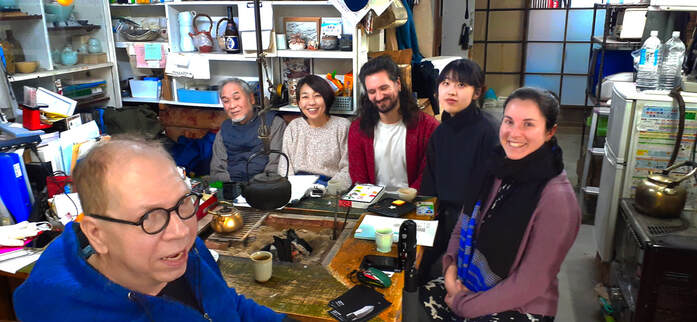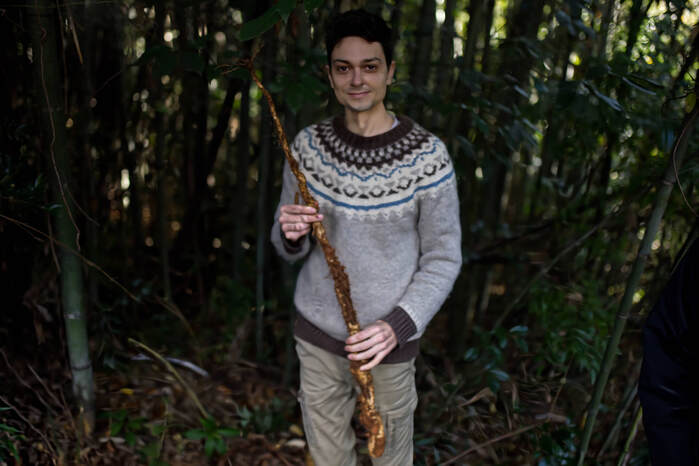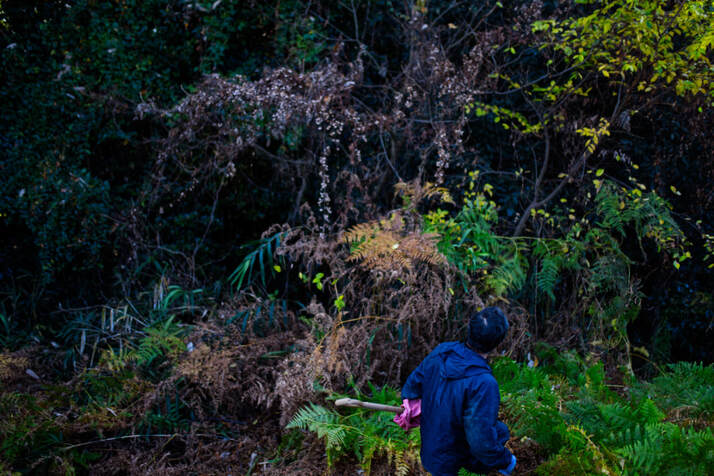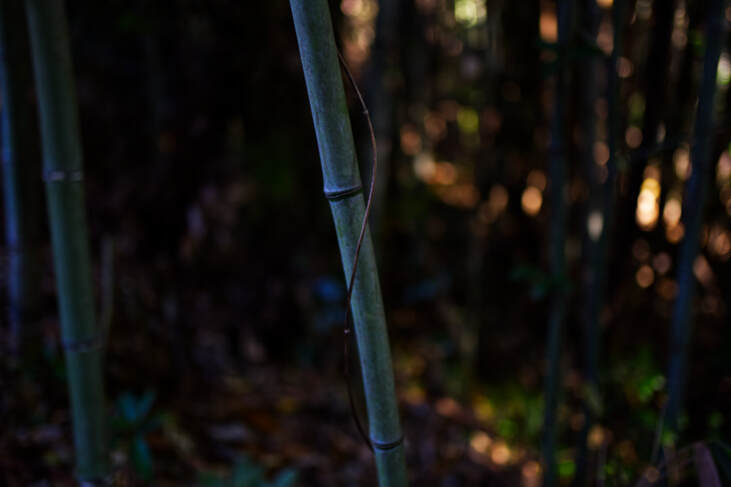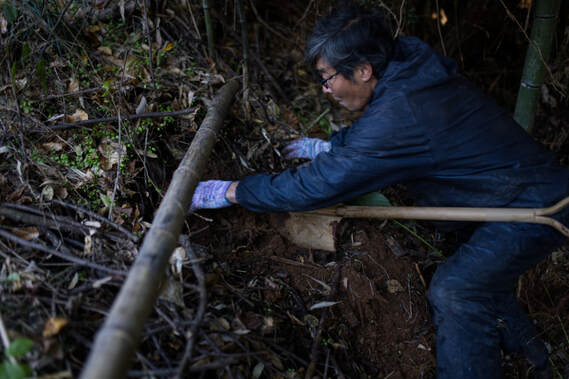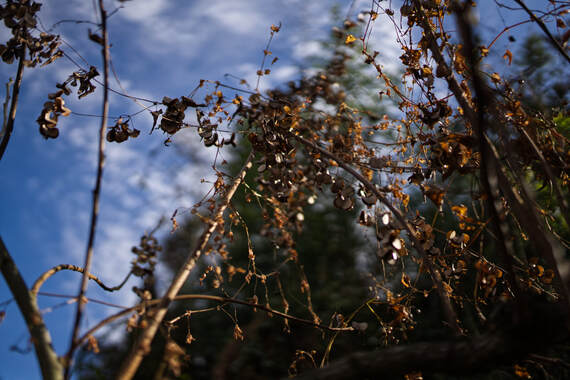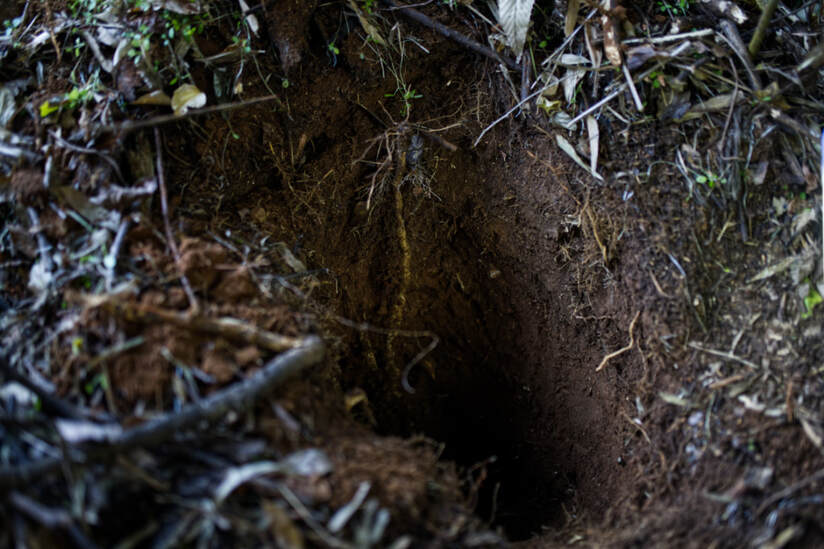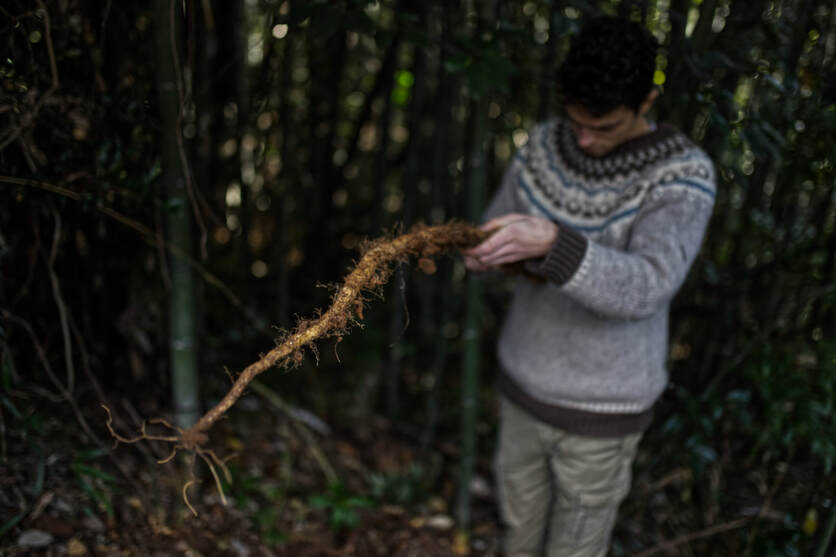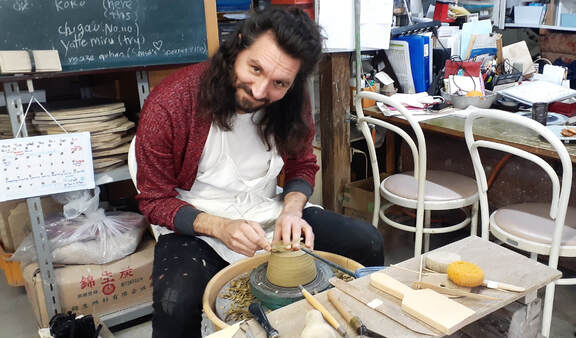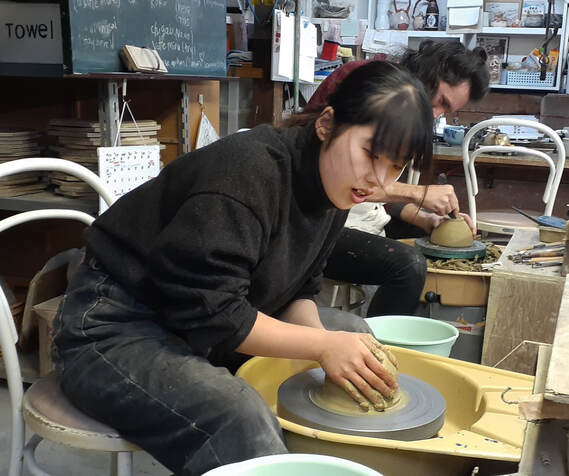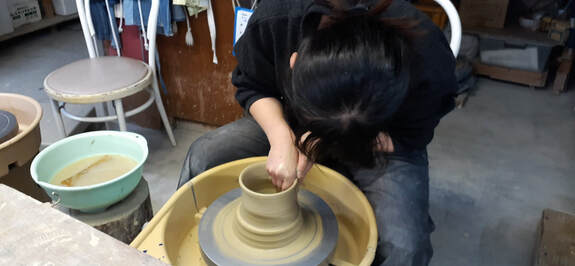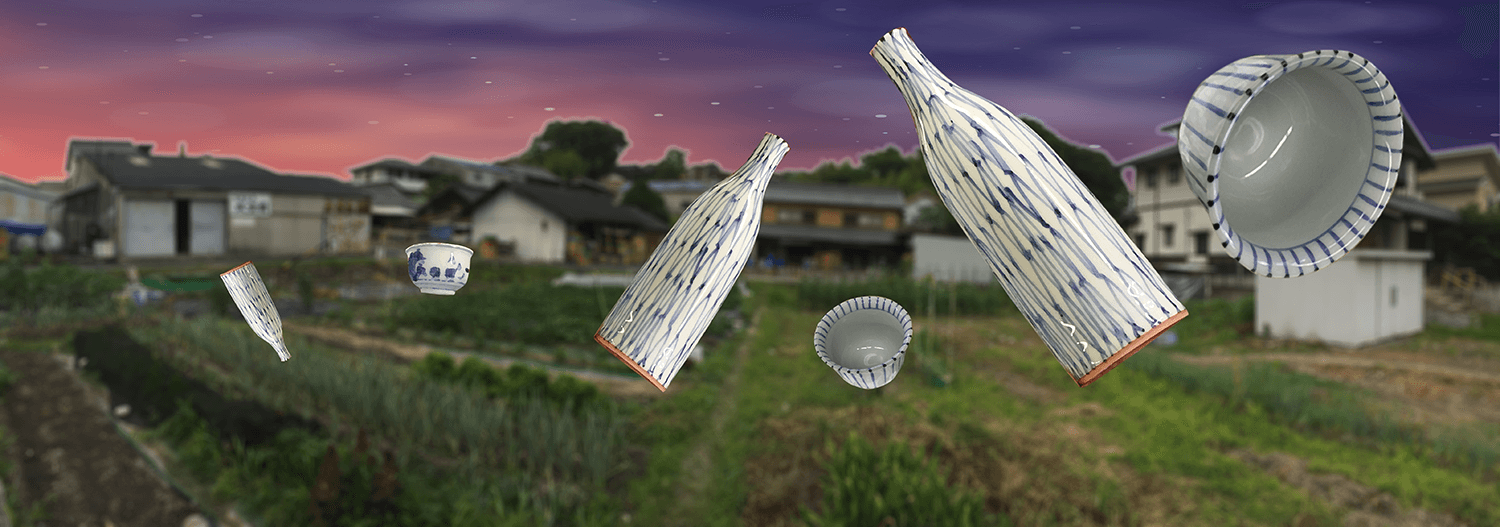To Tajimi and back
impressions of authentic japan
Nicolai, the German Yam entrepreneur
This site, Discovertajimi.com, has been running for a few years now and has matured into a place many Google searches about Japan end up. It’s always encouraging to see how people find articles that were published years ago, and one such piece dates back to 2018, when we wrote about the Japanese wild yam and its role in the New Year’s celebrations.
On November 23, 2022, Mr. Nicolai Schmidt from Germany wrote to us to inquire about a visit to Tajimi:
"I am 28 years old and doing a research project about Japanese yam. Now I am in Aomori, where I am learning about nagaimo cultivation. I am especially searching for organic farms that do not use mineral fertilizers and pesticides. However, I am also looking for jinenjo (wild yam). According to Hans Karlsson's article, it grows in the mountains surrounding Tajimi. I would really like to see it there or even join in digging it out. "I am also one of the very few biodynamic nagaimo cultivators in Germany, and I want to learn as much as I can about it here in Japan."
Imo is the Japanese word for "potato," and nagai is "long," so the word nagaimo is the name for a particularly long species of potato. Jinenjo (自然薯), or Japanese mountain yam (the botanical name is Dioscorea japonica), on the other hand, is its wild cousin. It is regarded as a real treat; it is packed with many healthy qualities such as fiber, minerals, and antioxidants. It lives deep underground and requires a lot of work to find and dig out.
We were quite pleased that Nicolai showed such interest in this local delicacy. He would, in fact, turn out to be a real potato nerd. After some asking around, we were able to locate a local "meijin," or "famous man," a person with expert knowledge in a certain field. He was said to have deep insights into things you can find in the mountains, such as valuable plants, wood, and so forth. We were told that he made his living by selling such items to local buyers, but that he was also shy and unsure about guiding a foreigner up in the mountains. That he didn’t speak a word of English didn’t help either. So, we promised to help out and document the two men’s adventure.
We were quite pleased that Nicolai showed such interest in this local delicacy. He would, in fact, turn out to be a real potato nerd. After some asking around, we were able to locate a local "meijin," or "famous man," a person with expert knowledge in a certain field. He was said to have deep insights into things you can find in the mountains, such as valuable plants, wood, and so forth. We were told that he made his living by selling such items to local buyers, but that he was also shy and unsure about guiding a foreigner up in the mountains. That he didn’t speak a word of English didn’t help either. So, we promised to help out and document the two men’s adventure.
Nicolai was apparently staying in a lodge in another village, and we were told he would arrive at our house by bicycle. We were a bit worried about whether he would find his way. We were to set out early in the morning, and it was quite chilly. We put on our warm clothes, stepped out of the house, and crossed the street to the parking lot on the other side when we noticed a very tall, slim foreigner was standing there chatting with a Japanese man who looked like a "meijin" indeed. But that person was not supposed to be able to speak English. We were quite confused. It turned out both men were exactly the people we were to assist, and they were getting along very well, although they didn’t understand one word of what they were saying to each other. The meijin had bought coffee for the guest at the convenience store, and they were having a good time.
Nicolai turned out to be a very nice guy and very serious and knowledgeable about potatoes. He told us that a similar kind of potato to the jinenjo had been brought back to Germany a very long time ago and that people were able to grow it in Europe, although it was still very rare. Now he wanted to bring the Japanese wild yam to Germany to try and see if it could be grown commercially and in an organic and natural way. The meijin told us that in Japan, normally commercial growers put the jinenjo in a vertical plastic pipe to stop it from growing downward. It is the natural "instinct" of the wild yam to grow very deep, and when it can't, it grows faster and bigger. However, Nicolai had an idea to let it grow the natural way and still be able to grow crops efficiently enough to sustain a business.
Soon we were up in the mountains looking for the valuable potatoes, and I began to realise this was going to be a challenge. The bamboo groves were very thick, and vegetation on the ground kept trying to snare my feet and make me fall. The meijin was incredibly quick, however, and moved fast and without hesitation in his spiked boots. I had trouble keeping up.
Soon the expert seemed to have found something and started digging frantically in the ground, deeper and deeper. In fact, the earth where the yam grows is very important, as the meijin explained as we dug deeper. It needs to be red and contain iron for the root to taste as it should. And you mustn't wash all of it off. "A little bit of earth adds to the taste in a very nice way." He told us that people from other tracts don’t understand this, and when they wash the root carefully, it makes local folks laugh.
The meijin managed to get the first long "tuber," as they are called, up, but it broke in the process. That would ruin it as a product, but for private consumption, it’s fine. We carried on and got into even thicker groves, like a jungle where you need a machete. Nicolai turned out to be a great jinenjo hunter. The vines can grow up to 4 metres tall and climb on trees and other structures. He looked like he was in his natural element, moving fast through the thick vegetation.
In the evening, we had a great meal, feasting on the jinenjo. Nicolai looked very happy. The wife of the man who had introduced us to the meijin had graciously prepared the jinenjo for us, and now we were in for a real treat. Despite the fact that we only spent one day together, the digging in the mountains and the party at the end have stayed with me as vivid memories. I know Nicolai has plans to grow this plant in Germany, and I often wonder how that went. As we'll see, we got some news from Europe on that.
Pottery students at the Ho-Ca studio
On February 18, 2023, I visited the Ho-Ca pottery studio again, one of my favourite places to visit in all of Tajimi. You always feel at home when you step into the slightly untidy but very warm and cosy studio where pottery master Setsuro Shibata teaches his students. He resembles a Japanese Gandalf wielding his clay magic. On the day of my visit, the studio had a new arrival, Martha from Pennsylvania, USA. She'd recently arrived in Japan for a two-month stay, and after some sightseeing, she'd spent a few days in Mizunami, a neighbouring city to Tajimi, where she'd worked as a volunteer farm hand in the vineyards. She got to try jinenjo yam as well—there was already a connection to Nicolai! Martha has a background in computer science but a strong interest in art as well; now she wanted to spend time exploring that other side of herself in a relaxed setting. I thought she had probably found just the right place.
There were also Julian from France, a furniture and interior designer based in Switzerland, and Kyoko from Niigata in northern Japan, who is currently studying at a university in Tokyo. Linda from Singapore had just finished her course but is planning to come back in November. The studio is very busy now; inquiries are landing in our mailbox in a steady stream. You can feel that the pandemic restrictions on tourism have been lifted.
I asked the students about their impressions. Martha looked like a very dedicated student, like the others I have met at Ho-Ca. Impressively, she had already picked up some Japanese, which I would really recommend you do if you plan to travel here. The Japanese are largely monolingual, and even a few words will go miles to improve your experience. Luckily, Shibata-sensei is a great communicator and uses a blackboard where the most useful words for instructions are scribbled. No one seems to be stuck because of the language barrier here.
"I am very satisfied with my study experience here," says Julian. I want to use what I've learned and incorporate it into my work as a professional designer. Indeed, balancing the modernistic and sharp look of his furniture and interiors with the organic feel of Japanese-style pottery seems like a very appealing idea. "Language and culture can be a barrier," he says, "but you just need to dive in and focus. And I love the authenticity of this place; it feels real. With all the things and clutter in here, you can walk around and study all the things and learn." "I only wish I had more time!" Even though Julian has already extended his stay by two weeks, he still feels that there is not enough time.
Kyoko seems very happy too. "We have no chance to get this kind of guidance in the study circle in my school," she says. "And we have no gas kiln, just an electric one. I get up at 6 in the morning and take an hour-long walk around the village. Last weekend, I went downtown to Oribe Street, looked at all the great pottery, bought some tools, and had lots of good food. I had so much fun! I also enjoy being here with foreign students; I learn a lot of English, not just pottery.
Being able to focus on a craft for an extended period of time like this is rare in today's hectic society. I tell Martha about Mu, the Japanese word for an empty space you enter mentally, completely disconnecting yourself from the distractions of the surrounding world. Mu is a key term in the philosophy of Zen Buddhism. The word is used in everyday Japanese as well, meaning something like "drifting off into a world of empty space." This can happen when you are completely focused on the clay on the potter's wheel, for example.
Martha put it very well: "I want to make the clay shape as I imagine it in my mind, not have it take over and take the shape it wants." Perhaps, I think, one way to accomplish that is not to fight the clay but to become one with it in the world of nothingness.
Kyoko attempting to work the clay. She was having trouble because she hadn't kept the clay moist enough.
Coming home
These dedicated students have yet to return home to digest their impressions and put them to use in their future work or hobbies. Nicolai, the Jinenjo entrepreneur, however, just wrote back to tell us what happened after his return to Germany.
"I am now continuing my Nagaimo research project at the University of Basel in collaboration with the Goetheanum (https://goetheanum.ch/en/). During the bad potato harvests caused by late blight disease (1) in the 1850s, the idea of cultivating Chinese yam (nagaimo) in Germany first arose. There were some trials, but probably it was too much work to harvest, so they did not continue.
I developed a nagaimo culture at a biodynamic farm in Germany and introduced the nagaimo to traditional German potato eaters at the market using a basic recipe I devised. Everyone really enjoyed it. The Japanese way of eating it, slimy and raw, is not preferred by everyone, but there are some who appreciate it a lot. In Germany, the Nagaimo is very expensive (approximately € 25-40 per kilo). That is because it requires so much manual labour to harvest it.
Furthermore, we need to make a ditch because most soils are not appropriate for the jinenjo. To make the growing process easier, I am doing some trials in Germany at different sites with different soils. I want to find a natural soil that is appropriate. And in Japan, I got to know the Nagaimo harvesting machines. I believe it would be a significant step to introduce the machines in Germany, but first the plant must become more popular as an aliment, and farmers with good soils who want to grow it must become more popular.
Therefore, I am doing the first part of my project: trying to understand the plant through comparing studies of the shapes of different plants. With that project, I was asked to come to the University of Basel (Switzerland), and I am in a collaboration with the Goetheanum, also close to Basel.
An authentic experience of Japan
All of these young visitors to Tajimi were able to experience a different side of Japan. Julian puts his finger on it: authenticity. Off the beaten path, you find authentic people, people who have the time to meet you on your own terms, as long as you are open to doing the same. We hope this article inspires more people to discover Tajimi, its people, places, and local culture. Drop us a line, and we'll try to help you.
Notes
1) Late blight is a potentially lethal tomato and potato disease that infects the leaves, stems, tomato fruit, and potato tubers.
